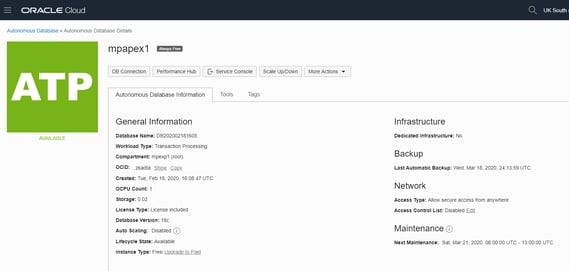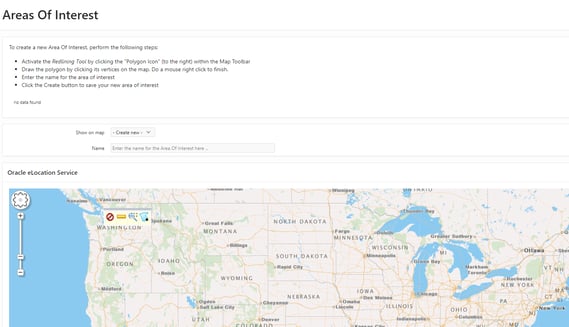- About
Getting to know us
- Services
- Managed Services
- Application Services
- Cloud Services
- Data Science
- Consulting Services
- Technology Solutions
Managed Services
Application Services
Data Science
Consulting Services
Technology Solutions
- Industries
- Resources
Resources
- Contact
- Contact us
ATP Features for APEX Developers
Contents
Oracle Autonomous Database (ADB), consisting of ATP (Autonomous Transaction Processing) and/or Autonomous Data Warehouse (ADW), refers to a cloud-based Oracle database service which ostensibly manages itself, by handling things like security, patching and performance tuning automatically, without the need for the intervention of a DBA. There are some immediately obvious benefits to this in terms of cost savings.
ADB uses Machine Learning to manage the database as it changes, allowing for operations such as auto-scaling, monitoring and performance tuning to occur with minimal human intervention.
Oracle offers access to an ADB instance free, with all features available as part of a 30-day trial period, with some feature remaining accessible without charge indefinitely (referred to as ‘Always Free’).
It is easy to get started with an Oracle Cloud account, just go to https://www.oracle.com/cloud/ to set up a new account, then setup an always free or trial account. Once you are set up, head to Autonomous Transaction Processing and create yourself a new database instance. You will then have access to a number of tools for database management and application development.
I won’t go into any more details on set-up, check out these blogs for more info:
- https://explorer.co.uk/adw-and-atp-always-free-databases-in-the-oci-if-you-snooze-you-may-lose/
- https://explorer.co.uk/how-do-i-access-my-free-oracle-cloud-database/
One of the things that has always been great about an Oracle DB license is that you get APEX for free. This means that with a license, you have access to a great web-based, ‘low-code’ (if you want it to be) development tool.
The Autonomous offering is no different; APEX comes as part of the always free bundle. Therefore, a developer could be starting to develop APEX apps within about 20 minutes of setting themselves up with a cloud account.
As APEX is essentially an in-built facet of a standard Oracle DB, the ‘autonomy’ of the database naturally extends to APEX itself. So aside for performance tuning an patching the underlying database which supports your Oracle application, ADB can upgrade your APEX instance for you as and when new versions come out.
Features
Aside from application management, there are a number of features that are available on ATP that an APEX developer could potentially utilise in their applications, some examples are:
- Spatial and Graph (Always Free)
Spatial and Graph functionality allows for the storage, retrieval and analysis of geometric and transactional data, allowing use of hundreds of data types that support geometric and graph analysis. I examine the features of Spatial and Graph in another blog:
- Machine Learning (Always Free)
ML functionality allows a developer, or data scientist, to generate algorithm to predict behaviour and/or patterns within an Oracle database. The functionality is accessible via a free ADB Cloud instance, via the Machine Learning Notebooks link.
As with Spatial and Graph, there are more details on these features in this blog:-
- Advanced security features
Oracle Claims that the ADB can protect against both external and internal attacks. It seeks to achieve this by applying automatic updates, encrypting client connections (using the Client Credentials Wallet) and using encrypting all data automatically using Transparent Data Encryption.
One example of a further feature available is ‘Data Redaction’ which can be used to mask data at runtime, when queries by applications such as APEX. This means that it is easy to apply a data-mask to, for example, a credit card number field in an APEX app, without affecting query performance or data integrity.
- Advanced Analytics
This functionality is designed for dealing ‘Big Data’ concepts and provides functionality around Data Mining and Statistical Analysis. Data Mining seeks to analyse massive amounts of data and determine complex patterns.
The Oracle Analytics Cloud is available on Platform Services -> Analytics. Here you can create a dataset and related visualisation, which can then be embedded into an APEX application.
Conclusion
There is a wide range of data analysis services now available to developers and organisations on ADB. In order get the most out of these products you might well need a team of data scientists and developers, plus a very clearly defined set of research goals. That said, the fact that these services are integrated into Autonomous and are natively exposed means that the ability to explore these is relatively easy and relatively cost effective.
Author: Michael Pickering
Job Title: Oracle Development Consultant
Bio: Michael is a Development Consultant at DSP-Explorer. Having attained an MSc in Computer Based Information Systems, he began his career developing health-care reporting solutions, before moving to specialise in Oracle Forms and Reports in the construction industry. Here at DSP-Explorer he is part of a highly skilled development team providing APEX development solutions and training to both UK and international businesses.

.png?width=250&name=stonewater-logo%20(1).png)



